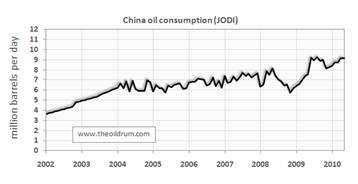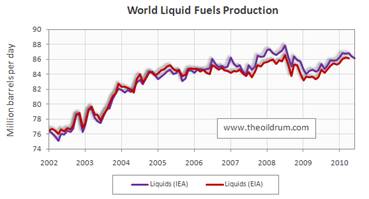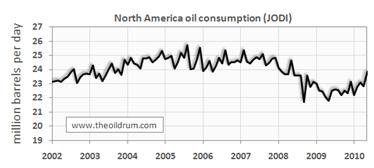China Becomes Largest Global Energy Consumer
Commodities / Energy Resources Aug 17, 2010 - 09:23 AM GMTBy: Joseph_Dancy
 Since the early 1900’s the U.S. has been the world’s largest energy consumer and the world’s largest auto manufacturer. It took a century to accomplish, but last year China knocked the U.S. from its perch as the world's largest auto market. Last month the International Energy Agency claimed China’s total energy usage exceeded the U.S. for the first time last year – making China the world’s largest energy consumer.
Since the early 1900’s the U.S. has been the world’s largest energy consumer and the world’s largest auto manufacturer. It took a century to accomplish, but last year China knocked the U.S. from its perch as the world's largest auto market. Last month the International Energy Agency claimed China’s total energy usage exceeded the U.S. for the first time last year – making China the world’s largest energy consumer.
 In June, China posted record crude oil imports of 5.4 million barrels per day. Over 50 per cent of the country's oil consumption is being supplied by foreign sources. Keep in mind China was an oil exporter as recently as 1992. China's total energy consumption was just half that of the U.S. 10 years ago, but in many of the years since China saw annual double-digit growth rates
In June, China posted record crude oil imports of 5.4 million barrels per day. Over 50 per cent of the country's oil consumption is being supplied by foreign sources. Keep in mind China was an oil exporter as recently as 1992. China's total energy consumption was just half that of the U.S. 10 years ago, but in many of the years since China saw annual double-digit growth rates
So far this year, China's crude oil imports are running at an average 4.77 million barrels per day, up a massive 30.2 per cent year over year. Total crude oil consumption was 8.71 million barrels per day on average, up 18.6 per cent year over year.
The IEA forecasts of China oil demand have been much too conservative. They expected China’s energy use to exceed that in the U.S. about five years from now. But with the global recession U.S. energy use was impacted more severely, slowing American industrial activity and energy use.
While current oil demand is of interest, the real trend investors should focus on is the fact that China’s oil consumption will grow quickly over the next few decades. In a recent report Raymond James discussed the soaring demand:
‘Despite China's attempts to slow down its breakneck economic growth rate, the surge in auto sales - up 48% y/y in 1H10 after a 45% jump in 2009 - is continuing in full force. We now estimate that an additional 20 million Chinese vehicles in 2011 could generate annual oil demand growth of 200,000 to 400,000 bpd.
This represents nearly a quarter of global oil demand growth from new Chinese cars alone. Add in increasing Chinese trucking, petrochemical and aviation consumption, and total Chinese oil demand growth in 2011 should be well north of 500,000 bpd and could drive over half of the global oil demand growth next year.’
The Globe & Mail published an interesting article on the future demand for energy from China—specifically crude oil:
‘. . . China’s energy consumption growth rates are even more impressive and were wildly underestimated by the IEA and other energy demand forecasters. Between 2000 and 2009, China’s energy use more than doubled, thanks to double-digit economic growth rates and a rising population. The IEA predicted energy use would rise 3 to 4 per cent a year. The real figure was four times greater. . . .
The United States is still the leading oil consumer, at 19 million barrels a day against China’s second-place 9.2 million. But China could catch up fast. There’s a reason why its oil companies have become the industry’s most voracious oil project buyers in recent years. Not long ago, China was a net oil exporter. Now it’s glomming onto every drop it can find, from Alberta to Sudan. . . .
Car ownership rates in China (and India) are very low by Western standards. A UBS report called “What if everyone in ChIndia had a car?” notes that only 4 per cent of Chinese over the age of 14 and 1 per cent of Indians have cars. In South Korea, the figure is 26 per cent; in the United States, 44 per cent; in Japan, 46 per cent.
If the car penetration rate were to reach simply the South Korean levels, it would imply a 1,125-per-cent growth rate in the number of cars in China and India, UBS says. That would boost global auto sales, in dollars, 5.7 times. . . . ‘
China's economic rise has required enormous amounts of energy—especially since much of the past decade's growth was fueled not by consumer demand, as in the U.S., but from energy-intense heavy industry and infrastructure building. And historically per capita use of energy grows exponentially once a country develops a large middle class that can afford automobiles, transportation services, housing, and more energy intensive diets. Should per capita demand for oil in China follow the historical path of those in the U.S., Korea, or Japan, oil imports to China will soar.
 IEA Forecasts. Global crude oil demand will grow by 1.35 million barrels per day (mbpd) next year to a record 87.84 mbpd, the IEA said in its recent report. That compared with demand growth of 1.77 mbpd expected this year, a figure the IEA revised up by 80,000 bpd in the report from its June estimate. The IEA expects total Chinese oil demand to rise by just 4.8% next year to 9.56 million barrels a day compared with robust growth of 9.1% this year.
IEA Forecasts. Global crude oil demand will grow by 1.35 million barrels per day (mbpd) next year to a record 87.84 mbpd, the IEA said in its recent report. That compared with demand growth of 1.77 mbpd expected this year, a figure the IEA revised up by 80,000 bpd in the report from its June estimate. The IEA expects total Chinese oil demand to rise by just 4.8% next year to 9.56 million barrels a day compared with robust growth of 9.1% this year.
As year over year demand increases continue at rates of over 1 million barrels per day the global excess productive capacity of fields will narrow—some experts claim 88 to 90 mbpd is the maximum global production rate from existing fields.
U.S. demand is still below pre-recession levels but is growing, and demand from developing countries continues to grow briskly. Demand in exporting countries continues to increase at rates well above average, in many cases a function of subsidized domestic energy markets.
Industry Studies – Lloyds’ Study . Lloyds of London has a new report out on the energy sector, predicting crude oil prices will trend upward. The report notes “a supply crunch appears likely around 2013…given recent price experience, a spike in excess of $200 per barrel is not infeasible.”
They summarize:
‘Modern society has been built on the back of access to relatively cheap, combustible, carbon-based energy sources. Three factors render that model outdated: surging energy consumption in emerging economies, multiple constraints on conventional fuel production and international recognition that continuing to release carbon dioxide into the atmosphere will cause climate chaos. . .
Energy markets will continue to be volatile as traditional mechanisms for balancing supply and price lose their power. International oil prices are likely to rise in the short to mid-term due to the costs of producing additional barrels from difficult environments, such as deep offshore fields and tar sands.
An oil supply crunch in the medium term is likely to be due to a combination of insufficient investment in upstream oil and efficiency over the last two decades and rebounding demand following the global recession. This would create a price spike prompting drastic national measures to cut oil dependency.’
Donald Coxe - Donald Coxe in an institutional conference call last month noted that “Big Oil” has failed to replace reserves over the last decade. Many oil reserves are located in risky areas of the globe with unfriendly governments. He concludes the trends in the oil and gas sector are ‘pretty stark’ – demand is growing but the ability of large firms to develop and produce reserves are limited.
Coxe thinks exploration constraints will favor smaller companies versus larger firms. His theme is to buy smaller companies with reserves in politically secure areas of the world. Coxe noted he was more optimistic on the outlook for the global economy after some of the recent developments, therefore energy demand should continue to increase. He notes economic uncertainty is higher than normal.
Saudi Arabia - Last month Saudi Arabia's King Abdullah ordered a halt to oil exploration operations to save the hydrocarbon wealth in the world's top crude exporting nation for future generations. Speculation as to why this ban was imposed, and what it means for the global energy sector, has analysts searching for answers.
Less than a year ago Saudi Arabia hired Halliburton to drill and complete oil wells in several older fields – including the Ghawar field, the largest field on the planet. Halliburton was going to use four rigs to drill 150 to 190 wells for production, water injection, and evaluation wells. Speculation is that depletion is impacting production capability – these are very old fields that have already produced a massive amount of crude oil.
A delegation of Saudi Arabian investment experts also met with BP last month about taking a position in the company for the Kingdom. If the Saudi government knows that oil production in their fields has peaked—or is stagnating at current levels as global demand grows—oil prices could move much higher, which might make an investment in BP very profitable and timely. These explanations are all speculative.
 Barclays. Barclays published a note last week discussing why they think crude oil under $100 a barrel is cheap. They note that the U.S. Energy Information Administration (EIA) revised higher its estimate for production lost from the Gulf of Mexico oil spill and drilling ban, noting that U.S. oil production in 2011 could be reduced by 82,000 b/d.
Barclays. Barclays published a note last week discussing why they think crude oil under $100 a barrel is cheap. They note that the U.S. Energy Information Administration (EIA) revised higher its estimate for production lost from the Gulf of Mexico oil spill and drilling ban, noting that U.S. oil production in 2011 could be reduced by 82,000 b/d.
EIA also revised its global demand estimates upward for 2010 and 2011. Data from the U.S. Department of Energy continue to showcase robust demand indications for the U.S.
Investment Implications. We think long term trends in the energy sector are bullish for investors. We agree with Donald Coxe’s strategy of investing in smaller companies with reserves in politically secure parts of the world. Our portfolio remains over-weighted in the energy sector.
By Joseph Dancy,
Adjunct Professor: Oil & Gas Law, SMU School of Law
Advisor, LSGI Market Letter
Email: jdancy@REMOVEsmu.edu
Copyright © 2010 Joseph Dancy - All Rights Reserved
Joseph R. Dancy, is manager of the LSGI Technology Venture Fund LP, a private mutual fund for SEC accredited investors formed to focus on the most inefficient part of the equity market. The goal of the LSGI Fund is to utilize applied financial theory to substantially outperform all the major market indexes over time.
He is a Trustee on the Michigan Tech Foundation, and is on the Finance Committee which oversees the management of that institutions endowment funds. He is also employed as an Adjunct Professor of Law by Southern Methodist University School of Law in Dallas, Texas, teaching Oil & Gas Law, Oil & Gas Environmental Law, and Environmental Law, and coaches ice hockey in the Junior Dallas Stars organization.
He has a B.S. in Metallurgical Engineering from Michigan Technological University, a MBA from the University of Michigan, and a J.D. from Oklahoma City University School of Law. Oklahoma City University named him and his wife as Distinguished Alumni.
Joseph Dancy Archive |
© 2005-2022 http://www.MarketOracle.co.uk - The Market Oracle is a FREE Daily Financial Markets Analysis & Forecasting online publication.



